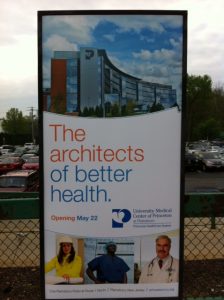
Ad in train station for Princeton's new hospital.
I'm on an evidence-based design blog post roll, so I figure I might as well continue it. I've been looking for project examples where the team used all 8 steps of the evidence-based design process, which you may recall from my post last week, are:
- Define EBD goals and objectives (organizational readiness stage)
- Find relevant sources of evidence (pre-design stage)
- Critically interpret relevant evidence (design stage)
- Create and innovate EBD concepts (design stage)
- Develop a hypothesis (design stage)
- Collect baseline performance measures (design stage)
- Monitor implementation of EBD concepts (construction stage)
- Measure post-occupancy performance results (occupancy stage)
Most architects and designers that I've contacted admit they have used some of the steps on recent projects, but not all.
Part of the reason, I suspect, is that the evidence-based design process was only recently formally defined (EDAC Study Guide 1, 2008), and recently completed projects were probably started 8-10 years ago. Another reason may be that no healthcare organization has committed to spending the time and resources to do all 8 steps.
Some of the participants in the Pebble Project whose buildings have opened in the past year have come close -- University Medical Center of Princeton, Ann & Robert H. Lurie Children's Hospital, and Palomar Health. Their facilities are incorporate, and in some cases, innovate, many evidence-based design concepts.
But whether they complete that last important step of measuring their performance results will be interesting to see. Because many of those who join the Pebble Project do so with good intentions to go all the way, but for whatever reason, don't make it.
What are some of the things that inhibit your project team from using all 8 steps in the evidence-based design process?
P.S. Please do me a favor -- if you liked this post and like this blog, please share it with others by sending them the link and/or post it on your Twitter, LinkedIn, or Facebook, etc. Also, don't forget to subscribe, so you'll get emails when new content is posted. Thanks!







